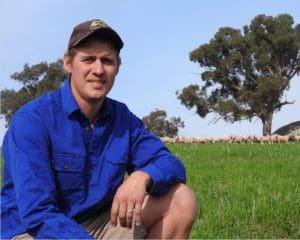
Farming Systems project officer with Holbrook Landcare Network, Ashley Paech.
EWE diet and fertility research findings in New South Wales which could dramatically boost Australia’s Merino ewe flock are being fine-tuned in on-farm trials.
Initial research results found that feeding ewes a pre-joining ration high in omega-6 fatty acids, based on oat grain, produced a higher proportion of female lambs, whereas a diet of pasture and silage rich in omega-3 fatty acids, was associated with a higher proportion of male lambs.
The research by the NSW Department of Primary Industries with the Graham Centre at Charles Sturt University has involved more than 1500 ewes since 2010. It examined the ratio of omega-3 and omega-6 fatty acids in the diet of ewes and the effect it has on the sex ratio of lambs.
Click here to get the latest Sheep Central story links sent to your email inbox.
In the trials, Merino ewes fed at joining on an oat grain ration rich in omega 6 fatty acids typically produced about 15 percent more ewe lambs than those on the pasture-based omega-3 diet.
However, the biggest difference in the number of female lambs produced on an omega-6-rich ration was 70pc from a mob Merino ewes mated to Border Leicester rams, versus about 40pc ewe lambs on the pasture-based diet.
The research indicates a sheep’s diet might influence the gender of offspring, giving sheep producers the ability to influence the sex ratio of lambs by manipulating maternal nutrition around the time of conception. The study has also shown that feeding an omega-6-rich diet to a ewe potentially boosted the reproductive potential of her female progeny.
“About 45pc females (ewe lambs) would be what we get typically get on an average or pasture-type diet and 15pc more females when we’ve fed the grain-based diets leading up to joining,” NSW DPI research officer Dr Ed Clayton said.
“The biggest difference we saw was in one trial with Merino ewes mated to Border Leicester rams and it was about 40pc female lambs when we fed the Omega-3s and it was 70pc females when we fed the Omega-6 diet.”
The omega-6 diet was made up of oats and cotton seed meal. The oats was 70pc of the dry matter intake of the ewes and the cotton seed meal was 8pc and remainder of the ration cereal or ryegrass silage.
The omega-3 diet was oat, wheat or ryegrass silage, or whatever forage silage was available, which had an omega-6 to omega-3 ratio of 0.3-0.5:1. In the grain-based omega-6 diet the ratio was 5-8:1.
“What we were targeting was around 70pc of their intake coming from the grain.”
Reproductive potential boosted in ewe progeny

NSW DPI livestock research officer Dr Ed Clayton.
Dr Clayton said researchers also had the opportunity to keep the Border Leicester-cross female offspring from Merino ewes fed the omega-6-rish ration for 17 days before joining and compare them for reproductive potential with the ewe progeny from ewes fed on a pasture-based diet.
He said the first cross ewes out of omega-6-fed mothers actually had a higher reproductive potential than first cross ewes bred from Merino ewes fed on pasture up to joining, after which they were fed the same diet during pregnancy and lactation. Over four years, the two groups of first cross ewes were joined to Poll Dorset lambs and fed the same diet at all times.
Dr Clayton said the number of foetuses per (first cross) ewe was higher among those whose mother had been fed the grain-based diet than those whose dams had been on the omega-3 diet.
“It’s not expected at all.
“It looks like we’ve actually changed some gene expression in those ewe lambs as like what is called foetal programming, although we can’t prove it is foetal programming just yet,” Dr Clayton said.
With the ability to get 15pc more ewe lambs from feeding an omega-6-rich diet before joining and a 15-20pc increase in the reproductive potential of ewe progeny, the increase in flock ewe numbers could be “pretty rapid” over five years’ time, he said.
On-farm trials and more controlled trials needed
Dr Clayton is now conducting on-farm trials in conjunction with the Holbrook Landcare Network to test these findings, with funding from Meat & Livestock Australia and Australian Wool Innovation. He said this would lead to some “best-bet” feeding guidelines for producers, but more controlled trial research into sheep diets was needed to better target ration decisions.
MLA General Manager – Producer Consultation and Adoption, Michael Crowley, said the research is positive news for producers.
“The initial research looks promising and field trials will determine if producers can influence the sex ratio to the preferred gender to target specific production systems through changing input management,” Mr Crowley said.
Dr Ed Clayton said work was being undertaken on 11 trial sites over a three year period to test the practicalities of the research on farms near Wagga Wagga and Holbrook, in southern NSW.
“We are looking at how the effect of feeding diets to unsynchronised ewes in a paddock feeding situation influences the sex ratio of the lambs, and the best sources of omega-3 and omega-6 to incorporate into practical on-farm rations,” Dr Clayton said.
The first of the on-farm trials began last year and involved five farms with a sample flock of 500 ewes split into two groups on each farm. Half the ewes grazed on pasture alone in the lead up to joining and the other half were supplemented with 600 grams of oats per day for four weeks leading up to joining and during the first two weeks of joining, giving them six weeks of grain.
“At the farm gate, the first year of trials didn’t show a huge difference in the sex ratio of offspring on individual farms.
“On some farms there was a 4-5pc difference in sex ratio, but other producers recorded no change,” Dr Clayton said.
“However, blood samples collected from a representative sample of ewes from each treatment group found there was a correlation between the fatty acid profile in the blood and the sex ratio of lambs.
“For example, on one property where there was no difference in sex ratio between the treatment groups, there was also no difference recorded in the fatty acids in the blood between the treatment groups,” he said.
“On properties where we changed the fatty acid profile, we saw a difference in the sex ratio of lambs.
“This provides some evidence that if the fatty acid profile can be changed through diet, we can influence the sex ratio of offspring.”
Dr Clayton said the next two years of trial work would address some of the practical challenges of managing the feedbase and conducting un-replicated trials on-farm.
“We’ll be looking at some of the variables which are difficult to manage out in the paddock.
“For example, the right length of feeding leading up to joining, how much grain to feed and what type of grain to feed, as well as how to more accurately account for the normal variation seen in sex ratios between mobs and individual paddocks,” he said.
Farming Systems Project Officer with Holbrook Landcare Network, Ashley Paech, is running producer interviews alongside the on-farm trials to seek feedback on the research and its relevance for farm businesses.
“Commercial producers can definitely see value in the research particularly in a building or rebuilding phase, so after drought for example, when it’s important to build ewe numbers,” Mr Paech said.

HAVE YOUR SAY